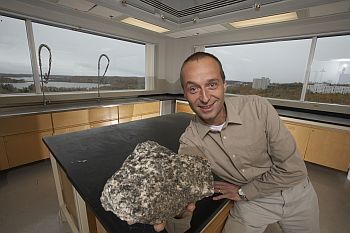 A new ultra violet laser ablation system on its way to Laurentian University's Trace Element Mapping Facility for Geological Samples positions the university's Earth Sciences Department as a North American leader in cutting-edge sample analysis.
A new ultra violet laser ablation system on its way to Laurentian University's Trace Element Mapping Facility for Geological Samples positions the university's Earth Sciences Department as a North American leader in cutting-edge sample analysis.
The new excimer laser ablation system, made possible by a grant of $170,900 from the Canada Foundation for Innovation, will replace a solid state system that is on the verge of exhaustion.
The device directs an ultra violet laser beam on a sample and vaporizes it into tiny particles, explained Dr. Balz Kamber, professor of Earth Sciences and Canadian Research Chair for Precambrian Geology.
The sample is enclosed in a cell with a window on top. The particles are entrained in a stream of helium gas that's introduced into the cell and directed through a tube to a mass spectrometer, which identifies the elemental composition of the material.
The sampling method can, for example, be used to determine the elemental composition of pyrites, said Kamber.
"It's sometimes easier to collect a large number of pyrites because they're abundant, and analyze the metal content of the other minerals in that pyrite in the hope that it will guide you to an area of mineralization."
"If we take a pyrite crystal, throw it in a beaker and digest it in acid, we assume that we're analyzing pyrite, but when we look at that pyrite crystal, it may turn out that at the microscopic scale, there are small inclusions of other minerals in there and we may actually not measure what is in the pyrite, but what is in these inclusions."
False conclusions
This can lead to completely false conclusions about the proximity of, say, a copper mineralization, said Kamber.
"We call this a characterization of the sample. We characterize samples with the normal optical microscope, but this has a limitation with respect to resolution. That's why we go to the secondary electron microscope to see very, very small features. It can also determine the major constituents of these imperfections and inclusions, but what it cannot determine are the so-called trace metals or trace elements.
"For this, we need an instrument that allows us to analyze these imperfections as well as the pyrite itself at very low limits of detection, and that is where laser ablation mapping is used."
Laser ablation mapping can be used to analyze drill core samples quickly and inexpensively. "If the results aren't interesting, you can switch off the drill and not have to wait six weeks for an assay," he said.
Laser ablation analysis also has implications for mineral beneficiation.
"If you're mining nickel, the processing plant has to be able to separate the pentlandite from the not so valuable ore, say, pyrrhotite," explained Kamber. "You may have platinum as a trace metal and assume it's in the pentlandite. With our method, we can map the pentlandite and discover whether the platinum is in the pentlandite itself homogenously distributed, or if it exists as miniscule nuggets in another platinum-rich mineral as an inclusion. That, of course, has implications for whether you only need to break up the pentlandite or whether these inclusions also exist in the pyrrhotite, in which case you shouldn't throw it in the dump. You should find a method of extracting these nuggets from what might otherwise be considered (waste)."
"I can foresee there being a demand for this type of work as the value of a potential deposit is being evaluated," said Kamber.
Alzheimer's
Laser ablation mapping also has applications in mine reclamation and in Alzheimer's research to discover possible links between changes in the frontal lobe tissue and the concentration of trace metals.
"There are several laboratories in Ontario and Canada with laser ablation inductively coupled plasma mass spectrometers and a hundred labs in the United States, but we are the first customer in North America for this particular type of (excimer) laser," said Kamber.
The Laurentian University lab has also acquired cutting-edge software that is able to quickly and inexpensively stitch together images.
The conventional approach to producing maps would typically take a day's worth of analysis and four days of sitting in front of a computer, said Kamber. With the software the Laurentian lab was able to acquire, an image can be produced in a fraction of the time.
There are two types of lasers. The solid-state variety produces the laser light through a crystal and has a limited life expectancy, while excimer lasers produce the light from a gas and are inexhaustible.
Kamber applied for and obtained funding for a solid-state laser ablation system five years ago, but it's now on its last legs less than halfway through its expected lifespan. The solid-state laser was originally used to analyze single spots, but in the last couple of years, a new method of using lasers, called laser ablation imaging, was developed.
"With single spot analysis, you drill for 20 or 30 seconds and stop," said Kamber. "In imaging, you raster across the sample for several hours without stopping and you use many, many laser shots, so although we only started employing this technique one year ago, we have shot through the laser in one year... It's still alive, but we are on borrowed time.
"When we realized the potential of the method, yet the deleterious effect it had on our laser, we decided to apply to the Canadian Foundation for Innovation to buy a laser which would be inexhaustible."
Apart from being inexhaustible, the new laser can be programmed to operate autonomously and has a larger cell able to accommodate several samples.
"You can tell the laser to raster an area for five hours, move to the next sample for four hours and so forth, so you can program it to run continuously," said Kamber.


